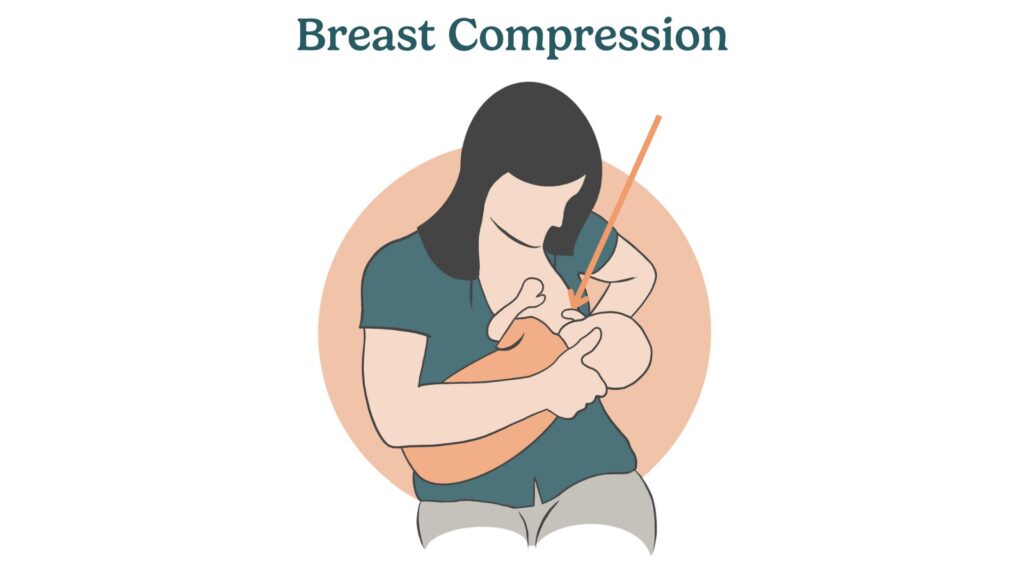breast compression

Breast compression
Breast compression is a technique used during breastfeeding to help your baby get more milk. It involves gently squeezing your breast while your baby is nursing to increase milk flow.
This method can be particularly useful if your baby is a slow eater, gets sleepy at the breast, or if you want to boost your milk supply.
What to watch out for
When using breast compression, it's important to be aware of a few potential issues and how to address them:
- Nipple pain: Incorrect technique can cause nipple pain. Make sure that you are compressing the breast tissue and not pinching the nipple. Put your hand in a C-shape, align your thumb and fingers on either side of the areola, and gently compress the breast to help milk flow. If you experience persistent pain, consult a lactation consultant for guidance on proper technique.
- Blocked ducts: Aggressive compression can sometimes lead to blocked milk ducts. Be gentle and use a consistent, moderate pressure. If you notice a firm lump or localized pain, massage the area gently and continue breastfeeding or pumping. If the issue persists beyond 24-48 hours, seek medical advice. Learn more about managing blocked ducts.
- Baby's latch: Make sure that your baby has a good latch before starting breast compression. A poor latch can cause discomfort and ineffective milk transfer. If you're unsure about your baby's latch, a lactation consultant can provide assistance. Learn more about a good latch.
If you encounter any problems while using breast compression, don’t hesitate to seek support from a healthcare professional or lactation consultant. Schedule a consultation and check your insurance for coverage.
Physical limitations or health circumstances
Certain physical conditions or health circumstances might affect your ability to perform breast compression effectively:
- Previous breast surgery: If you've had breast surgery, such as augmentation or reduction, it might affect your milk ducts and the overall structure of your breasts. Consult with your healthcare provider about the best techniques for your situation.
- Arthritis or hand injuries: Conditions affecting hand strength or dexterity, such as arthritis or hand injuries, can make it challenging to perform breast compression. In such cases, consider using a hands-free pumping bra or seeking alternative methods to boost milk flow.
- Engorgement: Severe engorgement can make it difficult to perform breast compression comfortably. If you are engorged, try using warm compresses and hand-expressing a little milk before nursing to soften the breast. Learn more about managing engorgement.
If you have any concerns about your health or physical limitations affecting breast compression, consult a healthcare professional or lactation consultant for personalized advice.
Other terms
Understanding related terms can help you better grasp the process and benefits of breast compression:
- Let-down reflex: The process by which oxytocin triggers the release of milk from the alveoli through the milk ducts to the nipple. Effective breast compression can help stimulate the let-down reflex.
- Milk ducts: The small tubes that transport milk from the alveoli to the nipple. Blocked ducts can interfere with milk flow, and gentle breast compression can help keep milk moving.
- Alveoli: The small sacs in your breasts where milk is produced. Compression helps to empty the alveoli more efficiently during feeding.
- Oxytocin: The hormone that causes the muscles around the alveoli to contract and release milk. Keeping stress levels low and creating a calm environment can enhance oxytocin release and improve the effectiveness of breast compression.
- Latch: How your baby attaches to your breast during feeding. A good latch is crucial for effective milk transfer and the comfort of both mama and baby. Learn more about a good latch.
- Nipple balm: A soothing ointment used to prevent and treat nipple soreness, especially when trying new techniques like breast compression. We advise against using lanolin-based creams; use “nipple balms” instead.


